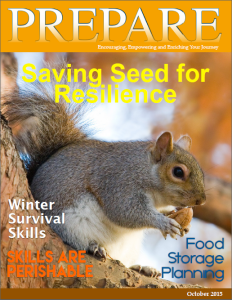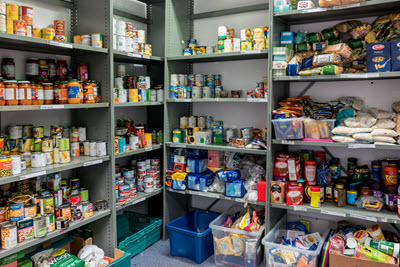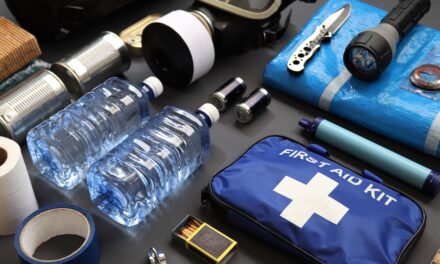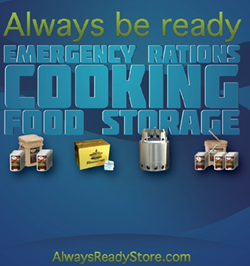When unpredictable circumstances strike, being prepared is your best line of defense.
Having an emergency food supply is a crucial aspect of this preparation. But what are the best foods to store in case of an emergency? This post will delve into the essential food items you should always have in your pantry, ensuring you’re equipped to weather any storm.
From long-lasting staples to nutrient-rich options, we’ll guide you through building a robust emergency food supply. You’ll gain actionable insights into selecting foods with long shelf lives, nutritional value, and easy preparation.
Stay tuned as we unravel the mystery of emergency food storage, equipping you with the knowledge to face any unexpected situation with confidence and calm.
What foods have a long shelf life?
 When preparing for emergencies, it’s crucial to stock up on foods that have a long shelf life. These include non-perishable items such as canned goods. Canned vegetables, fruits, and meats can last for years when stored in a cool, dry place.
When preparing for emergencies, it’s crucial to stock up on foods that have a long shelf life. These include non-perishable items such as canned goods. Canned vegetables, fruits, and meats can last for years when stored in a cool, dry place.
Dry goods like rice, pasta, and beans also have impressive shelf lives. These staples are versatile and can be used in a variety of meals. Don’t forget about whole grains as they are packed with nutrients and can last for up to a year when stored properly.
Another category to consider is freeze-dried foods and dehydrated meals. These items can last for decades, making them ideal for emergency food storage.
Condiments such as salt, sugar, and honey are also essential. Not only do they add flavor to meals, but they also have indefinite shelf lives.
- Canned goods
- Dry goods
- Whole grains
- Freeze-dried foods
- Condiments
Having a variety of these foods in your emergency pantry will ensure you’re prepared for any situation. Remember, the key is to store these foods properly to maintain their shelf life and nutritional value.
How to store water for emergencies?
In the event of a disaster, having an emergency water supply is as vital as having a stockpile of non-perishable food items. Water is essential for hydration, cooking, and hygiene. The rule of thumb is to store at least one gallon of water per person per day for a minimum of three days.
Storing water properly is crucial to ensure its safety and usability. First, choose the right containers. Food-grade water storage containers are recommended. These are made from a special type of plastic that will not transfer toxic substances into the water.
Next, treat the water before storing. Boiling is a common method, but you can also use household bleach. Add eight drops of bleach per gallon of water, stir and let it stand for 30 minutes.
Remember to store your water in a cool, dark place. This helps prevent the growth of algae and bacteria.
Lastly, rotate your stored water every six months. This ensures you always have a fresh supply in case of emergencies.
Remember, having a supply of stored water is as important as having emergency food supplies. In a crisis, these resources can be the difference between survival and disaster.
Can I store fresh fruits and vegetables?
When it comes to emergency food storage, fresh fruits and vegetables may not be your first choice due to their short shelf life. However, with the right preservation techniques, they can be a valuable addition to your emergency food supply. Canning, for instance, can extend the shelf life of fruits and vegetables for years. It involves sealing food in airtight containers and heating them to kill microorganisms that cause spoilage.
Another method is dehydration. Removing the water content from fruits and vegetables inhibits the growth of bacteria, making them safe to store for extended periods. Dehydrated fruits and vegetables can be rehydrated when needed, providing a nutritious addition to meals.
Freezing is another viable option. However, it requires a consistent power supply, which may not be guaranteed during emergencies. As such, it’s advisable to have a mix of canned, dehydrated, and frozen fruits and vegetables to ensure a balanced diet.
- Canning – Preserves fruits and vegetables for years.
- Dehydration – Extends the shelf life by removing water content.
- Freezing – Requires consistent power supply.
Remember, food safety is paramount when storing fruits and vegetables for emergencies. Always use clean containers and follow proper preservation techniques to prevent foodborne illnesses.
What are the best canned foods for emergencies?
When faced with an emergency, having a stockpile of canned foods can be a lifesaver. Among the top choices for emergency food storage, canned beans stand out. They’re rich in protein and fiber, offering the necessary energy and nutrients for survival.
Canned fruits and vegetables are also essential. They provide a variety of vitamins and minerals and can be used in different meals, making your emergency food supply more diverse.
Another excellent option is canned meats, such as chicken, turkey, or tuna. These are rich in protein and can be eaten straight from the can or used in various recipes.
Canned soups and stews are also a must-have. They are easy to prepare, require minimal additional ingredients, and can provide a comforting meal in times of stress.
Canned dairy products, like condensed milk or evaporated milk, can be used in a variety of ways, from adding to coffee or tea to using in baking or cooking.
Lastly, don’t forget about canned fish. Rich in Omega-3 fatty acids, they’re an excellent source of protein and can be used in many dishes.
Remember, the key to a good emergency food supply is diversity and balance. So, when you’re choosing what canned foods to store, consider their nutritional value, shelf life, and your personal preferences.
How to rotate my emergency food supply?
 Rotating your emergency food supply is a critical aspect of maintaining a fresh, nutritious, and safe stockpile. Start by organizing your supplies according to their expiration dates. Foods with the nearest expiry dates should be at the front, while those with later dates at the back. This “”first in, first out”” approach ensures that no food goes to waste.
Rotating your emergency food supply is a critical aspect of maintaining a fresh, nutritious, and safe stockpile. Start by organizing your supplies according to their expiration dates. Foods with the nearest expiry dates should be at the front, while those with later dates at the back. This “”first in, first out”” approach ensures that no food goes to waste.
Next, consider the type of food. Dry goods like rice, pasta, and beans have a long shelf life and require less frequent rotation. On the other hand, canned goods, although long-lasting, have a shorter shelf life and should be rotated more often.
Remember to keep a record of your stock. Having a detailed inventory will help you track what needs to be consumed first and what needs to be replaced.
Food rotation also involves using the stored food regularly. Use them in your day-to-day meals and replace them immediately. This method ensures that your emergency food supply remains fresh and familiarizes you with the preparation of these foods.
Lastly, storing a variety of foods not only provides nutritional balance but also prevents palate fatigue. Include a mix of grains, proteins, fruits, and vegetables in your emergency supply.
Remember, a well-rotated food supply is key to ensuring you have safe and nutritious food during emergencies.
Do I need to store cooking supplies?
Absolutely! When preparing for emergencies, storing cooking supplies is as essential as stocking up on non-perishable foods. You might have a pantry full of canned goods, but without the proper tools, you could find it challenging to prepare and consume these foods.
Consider keeping a manual can opener on hand, as electric ones will be useless during power outages. Also, a portable camp stove or grill can be invaluable for heating food when conventional cooking methods are unavailable. Including matches or a lighter in your emergency kit is a smart move too.
When it comes to utensils, opt for multi-purpose items. A Swiss Army knife, for instance, includes a blade, a can opener, and even a screwdriver – all in one compact tool.
Lastly, don’t forget about cleaning supplies. Hygiene is crucial in emergency situations to prevent the spread of disease. Include biodegradable soap, sponges, and disposable wipes in your kit.
Remember, the goal is to be self-sufficient during an emergency. Having the right cooking supplies on hand will ensure you can prepare and consume the foods you’ve stored safely and efficiently.
What is the importance of diversifying emergency food?
Diversifying your emergency food supply is vital for several reasons. Firstly, a variety of foods ensures a balanced intake of essential nutrients. Different foods provide different nutrients that your body needs to function optimally. For instance, canned vegetables are rich in vitamins and minerals, while whole grains provide much-needed fiber and energy.
Secondly, food diversity helps to prevent taste fatigue. Eating the same food repeatedly can lead to a lack of appetite, which can be detrimental in an emergency situation where maintaining strength and health is paramount. Including a mix of canned meats, fruits, vegetables, and grains can keep meals interesting.
Thirdly, certain foods can last longer than others. Combining non-perishable items with longer shelf life, like canned goods, with shorter shelf life items like dried fruits, ensures you have a food supply ready for immediate and long-term needs.
Lastly, diversification provides a safety net against food allergies or intolerances. Having a variety of foods ensures that if one or two items are unsuitable for someone, there are still plenty of other options available.
Remember, when building your emergency food supply, it’s not just about quantity, but also about quality and variety. This way, you’re prepared for any situation, from a short-term power outage to a long-term natural disaster.
Can I store dietary specific foods?
Absolutely! When planning your emergency food storage, it’s crucial to consider any specific dietary needs or restrictions. For those following a gluten-free diet, options like canned fruits and vegetables, rice, quinoa, and gluten-free crackers are excellent choices.
- For vegetarians and vegans, canned and dried beans, nuts and seeds, and whole grains are nutrient-dense foods that store well.
People with diabetes should focus on low-glycemic foods like whole grains, beans, and certain fruits. It’s essential to have a variety of non-perishable food items that cater to your specific dietary needs.
For those with high blood pressure or heart conditions, low-sodium canned vegetables, fruits, beans, and lean proteins are recommended. Always remember to check the labels for sodium content.
If you’re on a high-protein diet, canned tuna, chicken, or salmon, and dehydrated meats can be part of your emergency food supplies.
Remember, the key to effective emergency food storage is variety, balance, and consideration of dietary needs. This ensures that you have a healthy mix of foods that not only cater to your dietary requirements but also provide essential nutrients during emergencies.
Long-term storage foods like canned goods, dry mixes, and other staples can provide essential nutrients and variety in your diet. These foods are typically high in calories and nutrients, providing the necessary energy during emergencies.
Lastly, don’t forget about water. It’s advisable to store at least one gallon of water per person per day for at least three days. Water is essential for hydration, cooking, and sanitation.
Conclusion: Planning Your Emergency Food Supply
In conclusion, planning for emergencies by storing the right foods is a crucial aspect of preparedness. We’ve discussed the importance of selecting foods with a long shelf life, such as canned goods and dried foods, and how to properly store water for emergencies. We’ve also explored the possibility of storing fresh fruits and vegetables, albeit with a shorter shelf-life, and the importance of rotating your food supply to ensure freshness.
We’ve highlighted the necessity of storing cooking supplies alongside your food, and the significance of diversifying your emergency food supply to cater for nutritional needs and to prevent food fatigue. This includes considering dietary-specific foods for those with unique nutritional requirements.
As you plan your emergency food supply, remember that the key is to be proactive and versatile. Future trends may introduce new, innovative ways of food preservation and storage, but the principles of longevity, nutrition, and variety remain paramount. Stay informed, stay prepared, and remember that a well-planned emergency food supply can make a significant difference in times of crisis.








